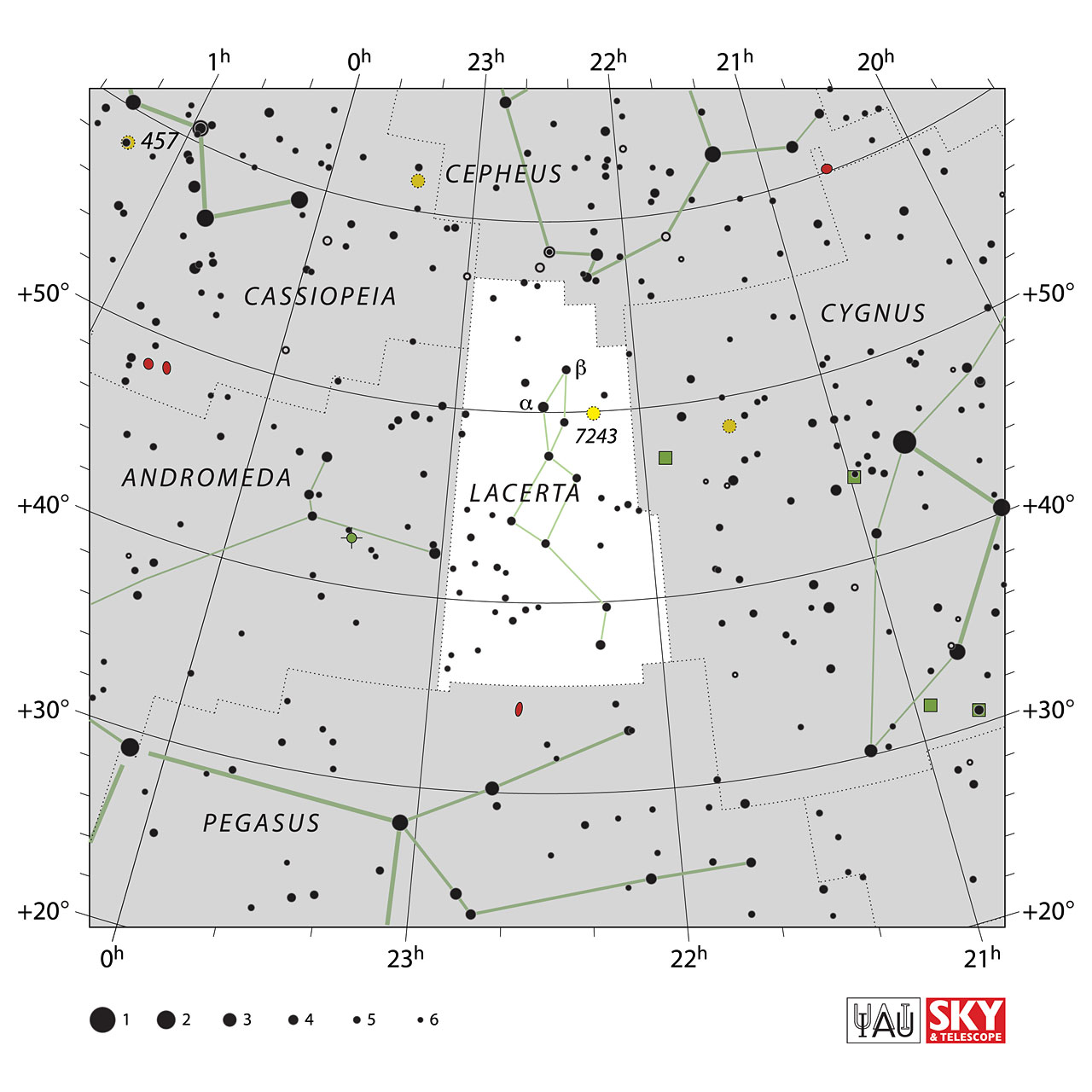Lacerta


Lacerta is a small northern constellation which appears highest in the midnight sky in the months around August.
Its brightest stars form a “W” shape similar to that of Cassiopeia, and it is thus sometimes referred to as ‘Little Cassiopeia’. It was introduced by the Polish astronomer Johannes Hevelius in 1690, filling an area of sky between Cygnus and Andromeda which lacks any bright stars.
Lacerta represents a lizard, though it only contains one star brighter than fourth magnitude. It is home to the open clusters NGC 7243 and NGC 7209, as well as the variable object BL Lac, the prototypical example of a blazar. Varying between magnitude 14 and 17, however, BL Lac is extremely faint and can only been seen through the largest amateur telescopes.
In India Lacerta is called ಮುಸಲೀ (Musalee)
Lacerta contains:
-
Stars
- α-Lac (mag 3.8)
- 1-Lac (mag 4.1)
- 5-Lac (mag 4.4)
- β-Lac (mag 4.4)
- 11-Lac (mag 4.5)
- HD 211073 (mag 4.5)
- 6-Lac (mag 4.5)
- 2-Lac (mag 4.5)
- 4-Lac (mag 4.6)
- 9-Lac (mag 4.6)
- 10-Lac (mag 4.9)
- 15-Lac (mag 5.0)
- HD 216946 (mag 5.0)
- HD 209945 (mag 5.1)
- 13-Lac (mag 5.1)
- HD 214665 (mag 5.2)
- DD Lac (mag 5.2)
- EW Lac (mag 5.3)
- HD 210715 (mag 5.4)
- HD 216174 (mag 5.4)
- HD 211096 (mag 5.5)
- EN Lac (mag 5.6)
- 8-Lac (mag 5.7)
- HD 211211 (mag 5.7)
- HD 216831 (mag 5.7)
-
Open Clusters
-
Globular Clusters
- None
-
Galaxy
- NGC 7242 (mag 12.0)
- NGC 7248 (mag 12.4)
- NGC 7250 (mag 13.1)
- NGC 7223 (mag 13.5)
- NGC 7426 (mag 13.6)
- NGC 7330 (mag 13.6)
- NGC 7265 (mag 13.7)
- NGC 7240 (mag 13.8)
- NGC 7231 (mag 14.0)
- NGC 7274 (mag 14.2)
- NGC 7379 (mag 14.4)
- NGC 7197 (mag 14.5)
- NGC 7264 (mag 14.7)
- IC 5180 (mag 14.8)
- NGC 7273 (mag 14.8)
- NGC 7227 (mag 15.0)
- IC 5191 (mag 15.0)
- NGC 7276 (mag 15.0)
- NGC 7228 (mag 15.0)
- IC 1441 (mag 15.3)
- NGC 7395 (mag 15.3)
- NGC 7282 (mag 15.3)
- IC 5193 (mag 15.5)
- NGC 7263 (mag 15.7)
- IC 5192 (mag 16.4)
View Lacerta in 3D 
Source: Wikipedia, in-the-sky.org
Image Courtesy: Sky&Telescope & IAU, Illustration Images linked from Urania's Mirror on Wikmedia Commons by Sidney Hall
Image Courtesy: Sky&Telescope & IAU, Illustration Images linked from Urania's Mirror on Wikmedia Commons by Sidney Hall
